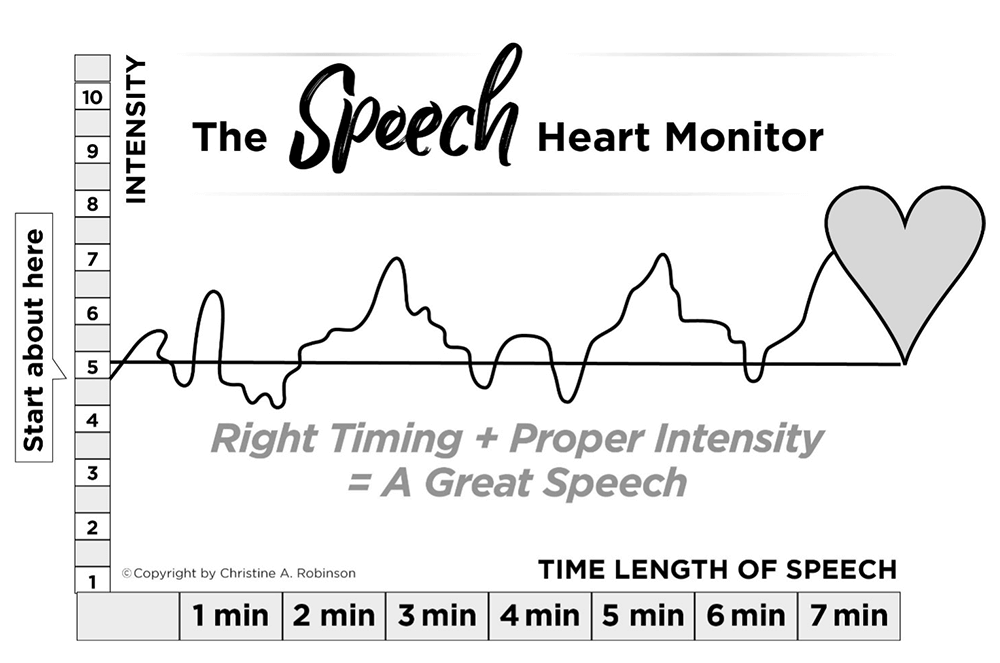Are you ready? Ready to become an inspiring, impactful speaker? As a three-time contender for the World Championship of Public Speaking®, and with 30 years’ experience teaching, authoring, and coaching, I’ve field-tested these strategies to elevate my speeches. Ahead are components of verbal and nonverbal communication—your keys to unlock the winning speech within you.
Prepare Your Speech
Determine your objective.
What do you want the audience to get out of your speech? Are you teaching, persuading, or inspiring? Are you trying to resolve conflict, give a call to action, or simply tell a story?
Answer "The Question."
The audience always has an unspoken question: “What’s in it for me?” Within the first minute, you need to answer their question and let them know why they are listening to you. Keep this point in mind as you develop your speech.
Set three goals.
No matter what your topic, message, or objective, you want to focus on three aspects at the beginning:1. Let the audience know who you are.
2. Give them a reason to listen to you.
3. Provide a structure they can easily follow.

Set the Stage
Create an alluring speech title.
Five words or less is ideal. The title can underscore your theme, provide a compass point, or keep your audience guessing—as was the case with Willie Jones, 1997 World Champion of Public Speaking, and his title, “A Warm Boot.” You might wonder, a warm boot? Turns out, a “warm boot” refers to rebooting computers. His topic broadened to include the idea of “rebooting” ourselves—a wonderful weaving of topic with title.Jump right into your presentation.
You have 30 seconds to capture your audience’s attention. Use your first few seconds wisely with a quick quip, an anecdote, or a self-effacing story. Done with the right tone, being vulnerable or playfully self-deprecating gets the audience on your side from the start.
Keep it light.
Have some “get to know you” time at the start of your speech. While what you have to say might be emotional, audiences tend to be uncomfortable if they feel they have to console the speaker.Start with humor.
The quickest way to break down the invisible walls between the speaker and the audience is humor. The more I looked for laughter and humor for my speech projects, the more I found, for my speeches as well as my life. For instance, the theme for one of my World Championship speeches was the power of authenticity. My opening line was “Be yourself. Everyone else is taken!”
Put your best first.
Many speakers mistakenly save the best for last. However, numerous times my supposed “best for lasts” were really best as firsts. Put your best first and you upgrade your presentation with even greater conclusions than initially anticipated. I once opened by belting out a song rather than burying the music later on in the speech.Structure the Body of the Speech
Streamline your presentation.
Initially, my speeches voluminously verged on overtime. Repeatedly, my mentor would comment, “What are you saying?” Through constant focus on purpose, the extraneous was cleared away. Refer back to the speech objective and purpose. Then bring support with examples, stories, or vignettes.
Apply a universal theme to something personal.
If your theme involves something others may not have experienced, tie the two together: one personal, the other universal.I began my “Empty Chair” speech with an empty chair and me on stage, to represent my absence from my family. From there, the speech built to a call for the audience to consider the empty chairs in their lives, to restore absent members to the “table of life.” Not everyone has an estranged family, but there are empty chairs. By using this analogy, I was able to inspire people to make calls and fill their empty chairs.
Create a speech tempo.
Pace provides impact. Like a heart monitor, a speech reflects intensities, highs, and lows. Craft a speech with all three levels, and end on a high.

Consider the "I to we" quotient.
As often as possible, use we and us. When you speak in terms of I and me, people grow bored. When you speak in terms of we and us, they become engaged. Of course they are, you are talking about them! The “I to we” quotient must be weighted with as much we as possible to gain maximum connectivity to your audience. Open with a phrase using we—something wide-ranging—right from the start so you and your audience find equal footing. To discover how many times we, you, and I are mentioned, take advantage of the editing “Find” tool.Use storytelling to establish conflict.
If you start with “Life is good, things are great, and I look forward to the rest of my life,” people start looking forward to walking out. Instead, use stories to illustrate how to overcome or strive for something. For example, describe an unfolding problem, such as arriving late at the airport. The audience can then review their life path of arriving late or facing other stressful situations. The story allows them to join you, listen, learn, and be entertained by character development.
Add Polish
Repetition.
Repetition clarifies and emphasizes your message. By the third time you make a point, the audience can honestly say, “Now I know what the speaker is driving at.” Repetition can appear in phrases or even a single word.The late British Prime Minister Winston Churchill said the following in a 1941 speech during World War II: “Never give in, never give in, never, never, never, never. … In nothing, great or small, large or petty. Never give in except to convictions of honour and good sense.” You can hear the vehemency in his voice, simply through the repetition of the word “never.”
Pauses.
Provide room in your speech to pause, slow down, and wait for your audience to appreciate what you articulated. At first, the pause may feel like an eternity; however, with practice, it will become a familiar tactic. The power of the pause is a silent and sometimes overlooked strategy to bring greater gravitas to your presentation.
Activities.
Because people remember 80% of what they see and do (as opposed to what they hear), give them something to practice. Pose a question and ask for a show of hands, have people stand up and wiggle their arms for a minute, or have them take a deep breath.At the outset of one of his presentations, 1999 Toastmasters World Champion of Public Speaking Craig Valentine loudly challenged his audience, “Are you ready?!” In return the audience bellowed, “I’m ready!” Then, Craig asked his audience to “turn to your neighbor and say, ‘I’m ready!’” In the midst of a chorus of “I’m ready’s!” everyone was most assuredly ready! Noisy and memorable to this day.
Commit It to Memory
Once you have decided what you want to say, crafted a strong speech, and incorporated some additional polish, focus on what is often the most difficult aspect: memorizing the speech.
Here are a few techniques I suggest.
- Practice your speech first thing in the morning and before going to bed. Speeches seem to gel this way.
- Record your speech over and over, then listen to it before going to bed or in the car. Recordings never lie, and you will quickly discover your strengths and weaknesses. Yes, you’ll hear your verbal chaff such as “er,” “you know,” or “um,” but you’ll also learn to appreciate the beauty of your own resonance: the sound, the music, the tempo of your voice.
- Develop muscle memory while walking and delivering your speech. With only a limited amount of air while walking, you dive down to the heart of what wants to be said. So put on your shoes and head out the door for muscle memory.

Leave With a Memorable Ending
A strong opening and a memorable closing should be your primary focal points. Whether building a sentence or a speech, keep in mind the most impactful points lie at the beginning and at the end. When you come to the end, think about how you want your speech to be remembered. Maybe you want to inspire listeners to do something, or perhaps you want to convey a unifying moment.
Call to action.
If the purpose is to get your audience involved in your project, give them a next step to take. This creates a linear speech from Point A to Point B. If your speech promotes the Toastmasters International Convention, your call to action at the end could be, “For the contests, for the educational talks, and for the keynote speaker: Sign up!”
Circular structure.
The circular speech structure, where the ending picks up the threads of the opening, is my favorite. The verbiage from the opening can be woven into the conclusion, supporting the speech with symmetry and balance. My award-winning “Empty Chair” speech opened by standing and addressing an empty chair, and concluded with my filling it.Finally, smile and enjoy your well-earned applause. You worked hard for this moment. The audience completes the cycle of giving and receiving as they thank you, putting their hands together in warm, welcome acknowledgement.
Watch Christine A. Robinson, DTM, in this special workshop as she shares strategies for stage presence to build your confidence.
Christine A. Robinson, DTM is a member of Pitch Perfect Toastmasters, in San Rafael, California, and a charter member of Leaders Worldwide, in San Francisco, California. She coaches and mentors speakers, and is the author of the newly released book Confidently Speaking: The Speaker’s Guide to Standing Ovations. Learn more at www.confidentlyspeaking.net.
Related Articles

Speechwriting
How to Build a Speech

Communication
5 Easy Tips for Crafting a Speech

Speechwriting



 Previous
Previous

 Previous Article
Previous Article